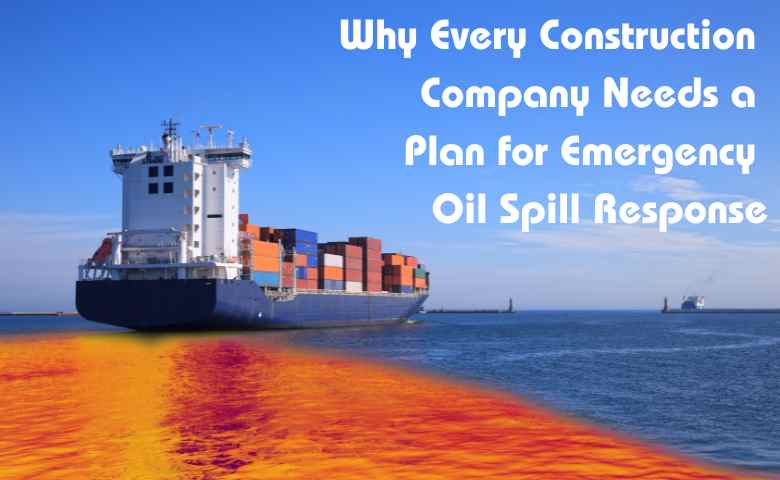Last Updated on November 19, 2025 by Admin
Construction projects rely heavily on fuel-powered equipment and machinery. Excavators, bulldozers, cranes, and generators all run on petroleum products that can spill if storage tanks leak, hoses crack, or fueling operations go wrong. While most spills are small, even a few gallons of oil can create serious environmental and financial consequences.
ConstructionCareerHub App is LIVE — built ONLY for construction careers. Don’t apply with a weak resume.
Get ATS-ready Resume Lab + Interview Copilot + Campus Placement Prep (resume screening, skill gaps, interview readiness) — in minutes & Other advanced features.
Explore Smarter Construction Career Tools →Quick check. Big impact. Start now.
Without a plan, site managers risk scrambling in the moment, which often leads to greater damage and higher costs. A proactive emergency oil spill strategy ensures that teams know exactly what to do when an accident happens. More importantly, it shows regulators and communities that the company takes environmental stewardship seriously.
The High Stakes of Oil Spills
Some construction companies underestimate the impact of an oil leak until they face it firsthand. The fallout often goes beyond the immediate mess.
The risks include:
- Legal Liability: Environmental agencies at the local, state, and federal levels impose strict reporting and remediation requirements. Failure to comply can lead to steep fines.
- Environmental Harm: Oil can seep into soil, storm drains, and nearby water sources, damaging ecosystems and harming wildlife.
- Reputation Damage: A single incident can draw negative media attention and reduce public trust in your company.
- Financial Loss: Cleanup, project delays, and regulatory penalties add up quickly, impacting profitability.
That’s why having a clear plan in place is not optional. It is an essential part of operating responsibly and maintaining business continuity.
Many companies choose to work with specialists in emergency oil spill response, who can provide expert containment, cleanup, and compliance support. These partners offer rapid deployment when accidents occur, but they also help build preventive strategies that reduce the likelihood of major spills in the first place.
What an Effective Response Plan Includes
Every construction site is different, but a strong spill response plan covers three key areas: containment, cleanup, and reporting. Each step has specific actions that must be carried out quickly and correctly.
- Containment
- Stop the source of the leak immediately
- Deploy absorbent pads, booms, or barriers to prevent the oil from spreading
- Protect drains and waterways to limit environmental exposure.
- Cleanup
- Remove contaminated soil, gravel, or water as necessary
- Use approved disposal methods to avoid secondary contamination
- Document every step of the cleanup for reporting purposes
- Reporting
- Notify the proper authorities within the required timeframes
- Maintain accurate logs for regulatory compliance
- Share follow-up actions with stakeholders, including project owners and local agencies
Without a plan, teams often miss one of these stages, leaving the company vulnerable to penalties or environmental damage.
Building Preparedness Into Daily Operations
An oil spill plan should not sit in a binder on a shelf. It should be integrated into daily safety and operations protocols. This means training staff, running drills, and ensuring spill kits are always stocked and accessible.
Some practical ways to keep preparedness front and center include:
- Conducting quarterly inspections of fuel tanks, hoses, and fittings
- Specifying UL-142 or UL-2085–rated above‑ground fuel storage solutions—such as turnkey systems from Envirosafe Tanks—equipped with double-wall construction, integrated spill containment, leak detection, and overfill protection to reduce spill risk and support compliance.
- Training all equipment operators on proper fueling and refueling procedures
- Posting emergency contact information at fueling stations and storage areas
- Assigning clear roles to employees so there is no confusion during a spill event
Companies that weave preparedness into everyday routines see faster response times and fewer mistakes when emergencies occur.
The Role of Professional Support
Even the most diligent construction crews benefit from external expertise. Oil spill specialists bring advanced tools and regulatory knowledge that go beyond what a jobsite typically maintains.
For instance, they can deploy vacuum trucks, industrial absorbents, and remediation technologies within hours of an incident.
In addition to emergency response, professional providers can:
- Conduct site-specific risk assessments
- Train employees on spill prevention and containment
- Develop custom response kits tailored to the machinery on site
- Handle complex reporting requirements to keep projects compliant
Services like these not only reduce liability but also give project managers peace of mind that they are prepared for the unexpected.
Why Regulators Pay Attention
Environmental compliance has become a growing focus in construction. Agencies are holding companies accountable not just for how they build, but for how they manage their job sites. Oil spills, even minor ones, are easy to trace back to the source. Regulators expect immediate reporting and documented cleanup.
Failure to meet these standards can result in stop-work orders, project shutdowns, and public scrutiny. By contrast, companies with clear plans often resolve incidents quickly and demonstrate good faith to regulators. This difference can protect project timelines and help maintain a cooperative relationship with oversight agencies.
Final Thoughts
Construction companies face plenty of daily challenges, from tight deadlines to equipment breakdowns. Oil spills may not happen every day, but when they do, the impact can be severe. A proactive emergency oil spill response plan protects not only the environment but also the company’s reputation and bottom line.
Preparedness is not just about reacting to accidents. It is about creating a culture where safety, compliance, and environmental responsibility are part of the job. With the right plan in place, construction leaders can build with confidence, knowing they are ready for whatever challenges arise.
Related Article
- Construction Career Launchpad: A Comprehensive Guide to Construction Job Preparedness
- Maintain your sofa covers – Smart and useful maintenance tips
- Smart Building Solutions: Enhancing Security and Safety in Commercial Buildings
- How to store Hazardous Substances on a Construction Site
- The Construction Industry’s Response to Climate Change


